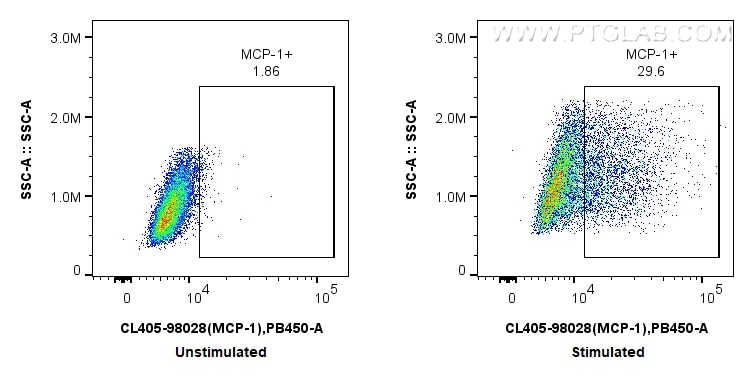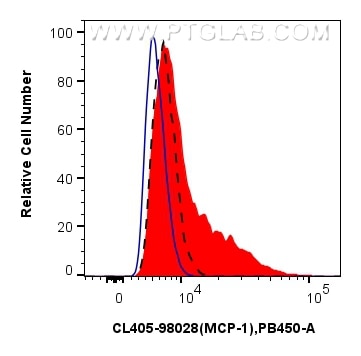Anticorps Recombinant de lapin anti-MCP-1/CCL2
MCP-1/CCL2 Recombinant Antibody for FC (Intra)
Hôte / Isotype
Lapin / IgG
Réactivité testée
souris
Applications
FC (Intra)
Conjugaison
CoraLite® Plus 405 Fluorescent Dye
CloneNo.
230483A9
N° de cat : CL405-98028
Synonymes
Galerie de données de validation
Applications testées
| Résultats positifs en FC (Intra) | cellules RAW 264.7 traitées au LPS et à la bréfeldine A, |
Dilution recommandée
| Application | Dilution |
|---|---|
| This reagent has been tested for flow cytometric analysis. It is recommended that this reagent should be titrated in each testing system to obtain optimal results. | |
| Sample-dependent, check data in validation data gallery | |
Informations sur le produit
CL405-98028 cible MCP-1/CCL2 dans les applications de FC (Intra) et montre une réactivité avec des échantillons souris
| Réactivité | souris |
| Hôte / Isotype | Lapin / IgG |
| Clonalité | Recombinant |
| Type | Anticorps |
| Immunogène | Protéine recombinante |
| Nom complet | chemokine (C-C motif) ligand 2 |
| Numéro d’acquisition GenBank | NM-011333 |
| Symbole du gène | MCP-1/CCL2 |
| Identification du gène (NCBI) | 20296 |
| Conjugaison | CoraLite® Plus 405 Fluorescent Dye |
| Excitation/Emission maxima wavelengths | 399 nm / 422 nm |
| Forme | Liquide |
| Méthode de purification | Purification par protéine A |
| Tampon de stockage | PBS with 0.09% sodium azide |
| Conditions de stockage | Store at 2-8°C. Avoid exposure to light. Stable for one year after shipment. |
Informations générales
Monocyte chemotactic protein 1 (MCP-1; also known as CCL2), is chemotactic for monocyte/macrophage, B-cell, and T-lymphocyte, and belongs to the CC subfamily of chemokines. Chemokines are a superfamily of secreted proteins involved in immunoregulatory and inflammatory processes. The human ortholog has been implicated in the pathogenesis of diseases characterized by monocytic infiltrates, such as psoriasis, rheumatoid arthritis, and atherosclerosis.
Protocole
| Product Specific Protocols | |
|---|---|
| FC protocol for CL Plus 405 MCP-1/CCL2 antibody CL405-98028 | Download protocol |
| Standard Protocols | |
|---|---|
| Click here to view our Standard Protocols |



